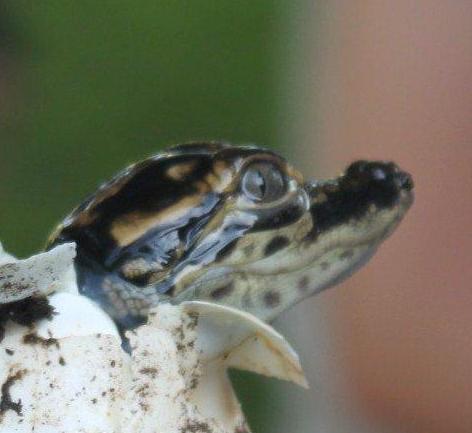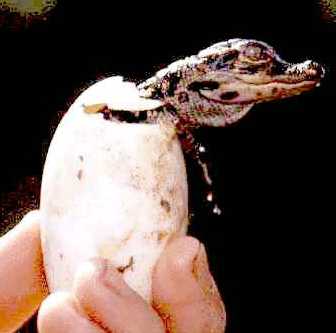 |
|
 |
-
Home - Park
Information - Programs,
Activities & Hikes - We've
Got Gators - Plants &
Animals - Get
Involved -
Members -

|
||||
 |
 |
|||
| Hatching Baby Alligator | Male Alligator | |||
Description - The largest reptile in North America. Females typically reach 6 -8 feet long, males can reach lengths of up to 16 feet. Color is dark green to black with lighter yellow on the ventral side. Back and top side of tail are covered by several rows of keeled scales. Head is large with nose and eyes set high on top. Nostrils and ears are equipped with valves to keep them closed while submerged. Legs are short and stout. Four toes can be seen on the front foot and five toes on the hind foot. Its large thick muscular tail makes up about one half of its body length. Voice - Males produce a loud, low rumbling noise that is often mistaken for thunder. This roar or "bellow" can be heard up to 1 1/2 miles away. Females also make a bellowing noise, but it is softer and does not carry as far. This roar is used to establish territory and to call in females for breeding. Young alligators make a chirping noise to alert others of approaching danger. They will also make a loud hissing noise by expelling air through their mouth as an aggressive gesture. Alligators will also slap their heads on the water and swish their tails behind them to make a loud splashing noise as a sign of aggression. Habitat - Alligators can be found in swamps, lakes, marshes, creeks and rivers, anywhere water can be found. Any permanent body of water can potentially play host to an alligator. Breeding - Breeding takes place in April and May when males can be heard bellowing. Males will approach females, placing his head or front legs over the top of the female and forcing her under water. This act is thought to be a display of his strength, to impress the female. If she is receptive she will allow the male to push her under water where breeding takes place. The male has no role in nest building or raising the young. Nesting - In June the female will chose a nest site near the edge of the water, where she will pile up grass, sticks, leaves and mud into a pile about 3 - 4 feet around and 1 - 2 feet tall. She will then crawl to the top of the nest, excavate a hole in it and lay between 30 - 60 eggs. Eggs are hard shelled and oval shaped, about 1 1/2 by 3 inches long. Eggs incubate in the nest, gathering heat from the sun and the rotting vegetation of the nest. Unlike most other reptiles, the mother alligator stays close to the nest, guarding it from possible predation from raccoons, skunks, opossums and coyotes. The mother will aggressively defend her nest by hissing, slapping her jaws and charging. Sex of the hatchling alligators is determined by the temperature of the nest. Nests with cooler temperatures produce females, nests with warmer temperatures produce males. Typically the top of the nest is warmer producing males and the bottom of the nest is cooler producing females. Hatching - Incubation period is about 60 days. At this time the baby alligators break their noses through the end of the shell, aided by an egg tooth, and start chirping. Others will chirp from inside an unopened egg. This is the signal for the mother to open up the nest. The mother will dig the nest open at the top and pick up the eggs in her mouth. She will take the eggs to the waters edge where she will carefully crack the eggs in her mouth. She will then open her mouth releasing the hatchling. This is repeated over and over again until all young are freed from the nest. The mother will keep the babies together in a group called a "pod". Raising Young - Hatchling alligators are about 6 - 8 inches long marked with black and yellow stripes. They will keep these stripes until they are about 4 years old. A thick, pink yolk sack bulges out of the belly of each hatchling. This will provide food for the young for about the first week. After the yolk sack is absorbed into the stomach the young must start looking for food. No food will be provide by the mother. Hatchling alligators feed on insects, worms, crustaceans, minnows, frogs, tadpoles or just about anything they can fit in their mouths. The young will remain with their mother for at least the first 6 months and will often remain by her side for several years. The mother does offer protection to her young. If the young are threatened they will make a chirping noise to alert the mother and other hatchlings of danger. Hatchlings will grow about 1 foot per year until they are about 6 feet long, at that point growth rate slows down. Survival rate of hatchling alligators is very low. Only about 3 -4 hatchlings out of a hundred are thought to make it to adulthood. They are preyed upon by fish, wading birds, hawks and owls, river otters and raccoons, turtles and other alligators. Behavior - Alligators are aquatic, spending their time in or near the water. Alligators use the water to control their body temperature. During warm days they can be found laying out absorbing heat from the sun on logs and low banks. During the hottest parts of the summer the alligator spends most of its time in the water to keep cool. During cold weather alligators will stay in areas of deep water or they will excavate a den. These dens are normally dug back and up under the bank, almost like an underwater cave that the alligator can use to keep warmer in the cold weather. During cold weather alligators can hold their breath for up to 12 hours. During warm weather this drops to about 15 - 20 minutes. Although they might appear slow and clumsy on the land the alligator is capable of incredible bursts of speed over short distances. Alligators are not aggressive animals and will normally chose to flee when approached by humans. Alligators are opportunistic feeders, patiently waiting for an easy meal to come to them. Since alligators, like all reptiles, are cold blooded it is not necessary for them to eat everyday. A full grown alligator could survive on something the size of a raccoon once a week. Adult alligators feed on fish, turtles, snakes, birds, raccoons, deer and any kind of meat that they can get a hold of, including other alligators. It is thought that a large portion of a large alligators diet consists of smaller alligators. Alligators can live to be between 25 - 35 years old. Range in Texas - They can be found in the eastern half of the State near lakes, creeks and rivers. Alligators versus Crocodiles - There are no crocodiles in Texas. There is one species of crocodile that lives in the southern tip of Florida, the American Crocodile. For the most part crocodiles live in places like Africa, Asia, Australia and South America. The shape of the crocodiles snout is much more pointed then that of the alligator. There is also a difference in their teeth. The top teeth of the alligator hang over the bottom jaw when the mouth is closed. On the crocodile some of the teeth from the bottom jaw over hang the top jaw. The coloration of crocodiles is generally lighter, almost a yellow - green, where alligators are green to black. Some species of crocodiles get much larger and much more aggressive than alligators. Alligators at Brazos Bend State Park - Alligator viewing has become very popular at the park and it is probably the best place to see a healthy unhunted inland alligator population. We estimate that we have between 250 - 350 alligators in the park that are 6 feet long and over. This population seems to be holding steady since before the park opened in 1984. There has never been alligator hunting at the park. The largest alligator is probably around 12 - 14 feet long. The alligators at the park are left on their own to find food, no food is provided by park staff. Alligators that are fed by humans tend to loss their fear of humans and become very aggressive. At the park the alligators take the right-of-way, we ask that you stay at least 30 feet away from them. Feeding, harassing, teasing or throwing objects at the alligators makes you subject to a large fine and expulsion from the park. Because of the alligator population, entering the water is not only a bad idea, it is illegal ! To date there has never been an accident at the park involving alligators and people, and we plan on keeping it that way. Alligator research at Brazos Bend State Park - Every year alligator nest are monitored to record number of eggs, location, date of hatching, and females are captured and tagged. This is in an attempt to determine the age of the females and previous nesting history of the individual. In summer of 1999 a new research project was started to look at the immune system of the alligators. This involves capturing and collecting blood and tissue samples, tagging and releasing a large number of alligators. Hopes are that if we kind find out why these animals seem to be immune to infection, maybe this information could be applied to the human medical field. No alligators have ever been harmed during these projects. Updated: Aug 23, 2011 |
||||